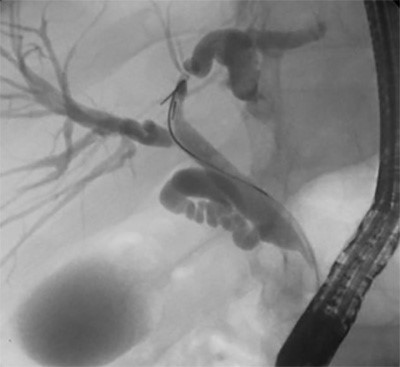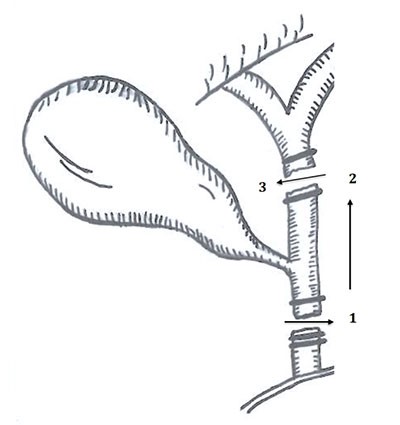Figure 2. Abdominal magnetic resonance image of the necrotic right hepatic abscess penetrating into the right pleural space and lung.
A bronchoscopy with bronchiolar lavage and lung biopsy was performed. Cytology and surgical pathology were negative, but the bronchiolar lavage specimen grew pan-sensitive S. milleri. Serum galactomannan, blood cultures, AFP, CA 19-9, and CEA were negative. Interventional radiology was consulted for aspiration of the presumed liver abscess, which was unsuccessful due to location and viscosity. The purulent aspirate was negative for bacterial and fungal growth and for E. histolytica antibodies. Azithromycin was discontinued, ceftriaxone was increased to 2 grams, and metronidazole 500 mg and pharmacy-dosed vancomycin were added. Despite a downtrending leukocytosis, the patient began complaining of right-sided pleuritic chest pain and RUQ pain, with fevers to 104°F and oxygen desaturation. Surgery was consulted at one week following presentation, and the patient was taken to the operating room for an exploratory laparotomy; right hepatic abscess drainage and resection; right diaphragmatic opening with empyema and lung abscess drainage and repair; and placement of a Jackson-Pratt drain and two thoracostomy tubes.
The patient immediately began to improve on postoperative day one. Panorex and echocardiogram were completed as part of the infectious workup, demonstrating two dental caries. Without other infectious sources, the caries were presumed to be the source of the positive bronchiolar lavage cultures, and the patient was placed on four weeks of ceftriaxone and metronidazole. He was discharged on postoperative day six without complication.
Discussion
When located adjacent to the diaphragm, PLAs may present with respiratory symptoms, such as pleuritic chest pain, cough, and dyspnea.4 However, it is rare for primary PLAs to cross the diaphragmatic plane into the pleural space and lung, especially in immunocompetent patients. Previous reports of transdiaphragmatic liver abscesses have been attributed to K. pneumoniae 2,3 and Entamoeba histolytica (E. histolytica).5
In this case report, we present a rare advanced transdiaphragmatic PLA secondary to a S. milleri dental infection in a non-bacteremic immunocompetent patient.
Members of the S. milleri group are commensal organisms of the oropharyngeal, gastrointestinal, and genitourinary tracts known to cause aggressive pyogenic infections, especially abscess formation.6 Typically, these abscesses form secondary to sepsis and hematogenous spread via the arterial system.1,6 In our case, S. milleri was presumably the PLA causative organism due to the positive Panorex and a lack of risk factors for primary liver disease or an intraabdominal source. While the consistently negative blood cultures and negative echocardiogram argue against hematogenous spread, the preceding one month antibiotic treatment possibly suggests incomplete treatment of the initial bacteremia that seeded the liver with S. milleri. Thus, with time, the PLA locally progressed into the lung and pleural space without bacteremia recurrence.
S. milleri infections typically present as monomicrobial non-metastatic localized abscesses of the central nervous system, head and neck, abdomen, and thoracic cavity.6 This is the first case of a localized S. milleri PLA that crossed a fascial plane in an immunocompetent host. Sunwoo and Miller reported the only other S. milleri infections that crossed a fascial plane; in this article, the patients were immunocompromised due to advanced age, smoking status, and/or an autoimmune disorder.6 In our immunocompetent case, the incompletely treated initial infection allowed the infection to progress mostly unnoticed, until the abscess reached a size causing the acute progression of symptoms. Whether this advanced presentation of S. milleri is the norm for delayed or incomplete treatment in an immunocompetent host remains to be determined.
In immunocompetent hosts, PLAs have the potential to go unnoticed or be undertreated, resulting in an advanced presentation of penetrating disease. For healthy patients who present with a moderate to severe constellation of symptoms, it is important to perform a thorough examination and to consider all possible sources of infection to ensure early detection and treatment of a PLA.
Conclusion
Advanced penetrating PLAs occur, but are often associated with K. pneumoniae or E. histolytica infection. While S. milleri can cause a PLA, they often occur locally and in immunocompromised patients. We present a rare case of penetrating PLA caused by S. milleri in an immunocompetent patient. This case demonstrates unlikely causes of advanced PLAs should be expected in the immunocompetent host, necessitating a complete workup to determine the source of infection.
Lessons Learned
In immunocompetent hosts, it is possible for incompletely treated S. milleri to cause advanced penetrating liver abscesses. A thorough workup, including Panorex, should be considered for immunocompetent patients presenting with symptoms of a PLA.
Authors
Victoria D. Vuong, MS; and Edie Y. Chan, MD
Correspondence Author
Ms. Victoria D. Vuong
Department of Surgery—Division of Abdominal Transplant
Rush University Medical Center
1725 W. Harrison St., Suite 161
Chicago, IL 60612
(630) 346-4723
Victoria_D_Vuong@rush.edu
Author Affiliations
Department of Surgery—Division of Abdominal Transplant, Rush Medical College, Chicago, IL
Disclosure Statement
The authors have no conflicts of interest to disclose.
References
- Krige JE, Beckingham IJ. ABC of diseases of liver, pancreas, and biliary system. BMJ. 2001;322(7285):537-540.
- Cho E, Park SW, Jun CH, et al. A rare case of pericarditis and pleural empyema secondary to transdiaphragmatic extension of pyogenic liver abscess. BMC Infect Dis. 2018;18(1):40.
- Lim KH, Tan YM, Chow PK. Liver abscess metastasizing to prostate and lung. J R Soc Med. 2002;95(11):554-555.
- Reid-Lombardo KM, Khan S, Sclabas G. Hepatic cysts and liver abscess. Surg Clin North Am. 2010;90(4):679-697.
- Patrício C, Amaral P, Lourenço J. An uncommon case of hepatopulmonary amoebiasis. BMJ Case Rep. 2014;2014.
- Sunwoo BY, Miller WT. Streptococcus anginosus infections: crossing tissue planes. Chest. 2014;146(4):e121-e125.







